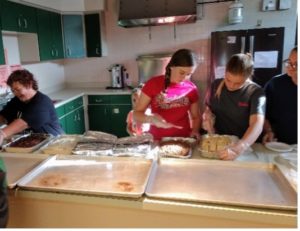The Seed Is Planted
In 2018, my husband Jim and I attended a one-day “What Is Dinner Church” meeting. On the drive over we spent an hour coming up with every reason that Dinner Church would not work in our town of Fort Meade, FL.
“We have no money.”
“Our town is too small.”
“No one will want to do the work.”
“We have no building to have it in.”
Despite our reasons, at the training, we sat at separate tables, and each of us was convicted that Dinner Church had to happen in Fort Meade.
The first few minutes of our trip home were spent in silence. Neither of us knew that we had each been convicted. Then Jim said, “Well, there is that community center in the east part of town.” The rest of the trip home was spent coming up with all the ways Dinner Church could work.
The most common question we heard in response to our explanation about Dinner Church was: “How is this different from the once-a-month community dinner the church puts on?”
This was a great question because it opened the door to tell them more.
Planning and Planting
Over the next year, we developed a core team. Our co-leader, Dennis, had this to say about that time: “I truly believe that because we prayed as a group for that entire year prior we encountered fewer challenges than we would have without praying for God’s guidance.”
We took our group to a three-day training with Verlon and Melodie Fosner and his team in Cape Coral, Fl., where we received a few shocks.
The first shock was when we were told that we were there because our churches were actively declining or in maintenance mode and would be declining soon.
The second shock was a statement one of our local denominational leaders that “We can start 150 Dinner Churches for what it costs to start one typical church. So, we will give you $500 a month for the first six months.”
We wrangled with a mixture of emotions. We were insulted that our church was considered in decline, ecstatic at being funded for a startup, and shocked that our denomination was stepping out to fund Dinner Church!
This core team began meeting on Wednesday evenings. We chose Wednesday nights because Fort Meade is a very church-oriented community – Wednesday was church night. We knew if we wanted to reach the people who were unchurched or de-churched, we stood a better chance of holding Dinner Church while all of the church people were in church!
The core team read and discussed Welcome To Dinner, Church. To say this book propelled us forward is an understatement. Through the discussions we found we were really forming as a team – going through all those stages of team development: forming, storming, norming, performing.
The real momentum happened when we began the coaching sessions with Verlon’s team. We listened to the struggles from other churches and realized we weren’t alone. This gave us courage to forge ahead and always bath our decisions with prayer and guidance from the Holy Spirit (unusual in our church tradition).
We listened to the struggles from other churches, realizing we weren’t alone and taking courage to forge ahead, always bathing each decision and move with prayer and guidance from the Holy Spirit
Tweet this.
One of the team members was a former employee of the city. He was able to secure us the Community Center at no cost—as this was a “public service”.
The next task was to really look at our city—honestly. Fort Meade is a bedroom community for Tampa, Lakeland, and Orlando. We did NOT have a grocery store – the state labeled us a ‘food desert’. The only local businesses were service-oriented with three small ‘restaurants’. Oh, and a Mcdonald’s!
We learned that the ethnic makeup of Fort Meade was seasonal. It is about 40 percent white from October through March when the population grows with the influx of ‘snow angels’ – retirees from the north. During the rest of the year, the make up is primarily Black, then Hispanic, various groups of seasonal workers, and lastly, Asian.
The city had been experiencing very high racial tensions—including the murder of three young black men. Fort Meade is a very segregated community. In fact, one of my parishioners was a former head of the KKK.
In fact, we were energized by the location of the Community Center, within walking distance of folks none of us saw in the churches we represented.
Prayer Walks
A few of us read Breaking Strongholds In Your City: How to Use Spiritual Mapping to Make Your Prayers More Strategic, Effective and Targeted, edited by C. Peter Wagner. (1993, Regal Books). Not all of the core team participated in the prayer walks – but we were joined by folks who were prayer warriors and later became integral volunteers.
We divided the city into sections. Note here that I had been told on several occasions by other pastors, community members, and city personnel that there were no homeless people, and no people living in abject poverty in Fort Meade. More eyes than our prayer walk teams’ were opened to the realness of poverty, neglect, and loneliness in Fort Meade. We discovered a ‘hidden’ village: Christmas Tree Village. It was nothing more than a swamp with old tin-can type trailers where seasonal workers and their families lived in less than abject poverty.

It was one of the prayer walks through Christmas Tree Village that led us to a family who would become part of the core team – and one of the miracles of Dinner Church. Rosa was the mom of 8 children and was expecting her 9th. She and her family were regulars at DC and even provided the meal one week – which they did at extreme cost to themselves as we prepared for at least 100 each week. Rosa gave birth – and her baby became our ‘Dinner Church’ baby.
The Holy Spirit moved powerfully through these walks. Most of the teams were under the perception (me included) that we would be changed. We learned that the prayer walks changed the community more than any of us. Word reached us through different venues that prayers were being answered and a ‘strange calm’ would come over a neighborhood after one of our prayer walks. Of course, there were those who claimed it was a coincidence.
We learned that the prayer walks changed the community more than any of us. Word reached us through different venues that prayers were being answered and a ‘strange calm’ would come over a neighborhood after one of our prayer walks.
Tweet this.
Training
Dinner Church training began in earnest in April of 2019 at the UMC where I served as pastor. The word was spread throughout the community through announcements in churches, and on social media. Several folks joined the team – but most who came decided that it sounded like way too much work for them. Showing the Dinner Church introductory video and other dinner church videos was very helpful for those of us who needed to see it to really get our heads wrapped around the concept.
There were usually about 10 – 15 people at each training. God brought 3 chefs forward. Two of the men were full into the concept of DC, the third was a challenge as he was a lone wolf. He would cook and serve but would not eat with the rest of the DC crowd. Some of the guys kept working with him and by the last few months of DC, he could be found at a table talking with others. We considered that a miracle.
We held two walk-throughs of dinner church at the UMC in June – looking toward a start-up date in July, 2019. These were logistic-type walk-throughs – trying to figure out what would make folks the most comfortable – the most family-like – and would it work when serving a group.
In June we held a dress rehearsal, inviting folks from our churches and civic groups. There were about 20 people in attendance. It was a wonderful time of ironing things out. We discussed what slowed the process down in the kitchen, how a Jesus-talk really came across, and how we would practically be disciples at the tables. It was decided that we each would sit at the same table each week, with the same people to develop relationships. We had some mishaps – we had to cook the food off-site and transport it to the Community Center. One pan of green beans became the floor covering in my van – but that was really the worst that happened.
The Fruit- Dinner Church
Finally, opening day arrived. We went way out on a limb and prepared enough food for 50 people! The anticipation was that if we had 20, we would be blessed. Sixty-eight people came that first night. The numbers rose from there to over 100, then settled in at an average of about 80.
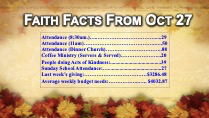
In the church I served, at the beginning of the Sunday worship service, we had an announcement loop. In it was the slide above. Note that the 11 am service attendance was 50, and the attendance at DC was 88. This caused some healthy consternation in the traditional congregation. “When would “those people” be coming to church?”
The core team had to do a lot of helping people understand that DC was a campus of our church – it was not a launching pad to clean people up and send them over on Sunday.

The other real challenge was the attendance of our snow angels at DC. Snow-angels are folks from the north who winter in Florida. It was widely assumed that these folks were always on the lookout for a free meal. Indeed, the first few DC events were overpopulated by snow angels. The core team did a great deal of ‘counseling and explaining’ that they could come to DC if they didn’t attend another church, or they could come if they brought someone who was not churched or de-churched.
I also did a lot of direct preaching on Dinner Church and the drip method in the services – including pictures and short videos of DC (with the permission of DC members). The core team, volunteers and I learned to use the phrase: “Our other campus”.


Set up was handled by a team of gifted folks who made the tables each week special – from nice coverings to decorations in the desserts! Cards were placed on each table that explained what would happen during dessert. “After dinner, there will be a short 8 – 10 minute story about Jesus. You are invited to stay and join us for that if you wish. God bless you all.”
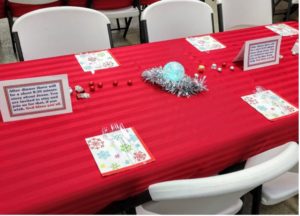
One of my favorite tables was the one for St. Patrick’s day, with little signs saying: “With Jesus, we don’t believe in lucky charms.”
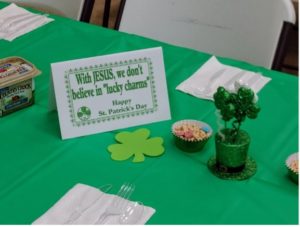
Early on we started a “Resource Table” where people could leave information… it also evolved into a networking site for those looking for work.
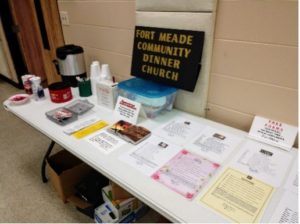
The middle school and high school kids became a delight in serving the meals at the buffet table – and having great fun serving the desserts tableside! Everyone found their niche.
What I learned looking back and looking forward
Since starting a Dinner Church, there were wonderful miracles and wonderful challenges. The greatest challenge for me was energy. It was hard to get to DC, but once I was there I didn’t want to leave.
Not wanting to leave was largely due to ‘my ladies.’ A group of ladies whom life had not treated well was at my table. In the picture below, the lady holding up the Bible was known as the “nastiest, vilest, just plain mean woman” in Fort Meade. She had been hurt by some event at church when she was growing up and didn’t want anything to do with any of us. But she came to DC as a favor to one of the other ladies at the table.
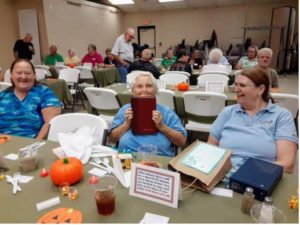
As we got to know one another, the life stories that came out broke my heart – and I soon developed tremendous respect for these women. The ‘mean’ lady finally said to me, a few months into DC: “You ain’t like no other pastor I ever knew. You seem real down to earth and practical. What’s your story?” As I told about being a kid on a farm, growing up dirt poor, but with a love for Jesus and learning, I could see that they were listening – really listening.
I believe that event broke down a lot of barriers; after that, there was a deeper connection at the table. The miracle was the day that the ‘mean’ lady told me she threw all her Bibles away years ago but would like to have one now.
Most heart filling for me was the mix of races. When I first came to Fort Meade, I was horrified by the segregation – and even more horrified that some people still used racial slurs in their day-to-day conversation! It was a definite them-and-us situation. I talked with the other pastors in town (all male) about this and was informed that it was the way it was and it would never change.
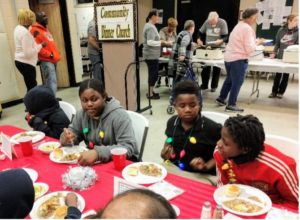

Don’t ever tell God that God can’t!
The kids became a focus for me. Some of the adult told me that the kids were “bad” and they weren’t going to let them come if their parents didn’t come with them. It became the tradition of Wednesdays that I would go to the local playground and collect the kids – I was their parent for the evening. Blessing the children, and having a children’s time became integral to our DC.
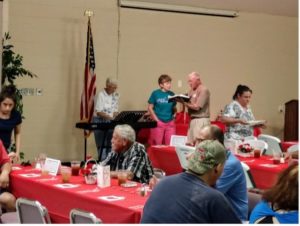
7 months into DC my husband was talking with one of his DC friends. The man was very close to retirement and life had not been easy for him. They were talking about their faith backgrounds, and the gentleman said he grew up Catholic in Mexico. Jim asked him if he went to church in Fort Meade; his response: “This is my church!” He is pictured below in the black plaid shirt.
In the fall of 2019, Fort Meade got a new Town Manager. She recommended to the town board that Dinner Church be charged $300.00 a month for the use of the Community Center. Our core group went to the meeting. I was very nervous – and gave a presentation on Dinner Church. The Town Manager claimed it was a Bible Study with dinner.
Little did I know that the members of the town board knew all about what was going on at the Community Center on Wednesday nights. They told the Town Manager about the lessening of racial tensions in the whole community, and that they ‘knew that a lot of problems got taken care of at DC before they ever became problems. “People are really beginning to like each other,” said one board member. The Town Manager wasn’t going to back down – until one of the board members pulled out his wallet and said “I’m paying for the first next three months (he laid money on the table, then challenged the group) who will pay for the 3 months after that?”
Shortly after this meeting, COVID hit and we were shut down. In the intervening time, a new city manager has been hired – and Dinner Church will be able to use the Community Center free of charge as it is a “service to the community”.

